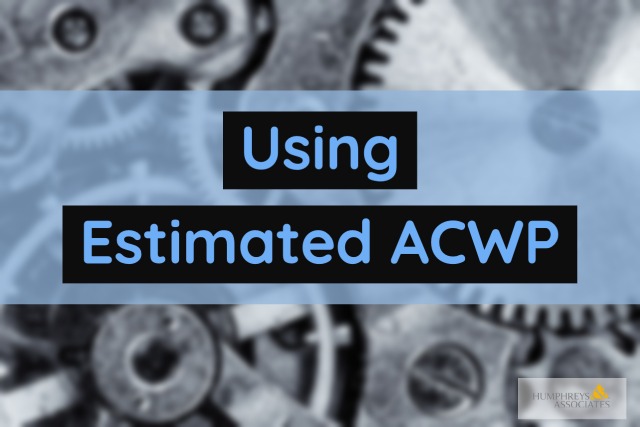
Estimated Actual Cost of Work Performed
The use of estimated actual cost of work performed (ACWP) for material and subcontractors is something the Defense Contract Management Agency (DCMA) review teams expect to see in Earned Value Management Systems (EVMS).
The review teams know:
- Many contractors earn value for a large amount of material at receipt
- Suppliers or subcontractors do not always invoice at the same time
- Contractors do not pay at the same time
VAR Narratives
DCMA increasingly sees variance analysis report (VAR) narratives for material with such statements as “My $1 million cost variance is caused by late receipt of the invoice from the vendor” or “is caused by the company not paying their invoice this month.”
These are misleading and needless variances because these drastic, temporary variances go away, or are minimized, once the invoice is paid and the actual costs in the accounting system catch up with the budgeted cost for work performed (BCWP) claimed. The intent for using estimated ACWP is to ensure that the ACWP recorded closely follows when the BCWP is claimed in the EVMS.
Real Cost Problem
When the estimated ACWP is “reversed” at the end of a month and replaced with the true actual costs, there should not be a significant cost variance, unless there is a real cost problem in which case more information is required to describe the situation. Replacing the estimated ACWP with the true actual costs is considered a routine accounting adjustment.
Note that the term “estimated ACWP” and not “estimated actual costs” is being used. The intent is to align when ACWP and BCWP are claimed in the EVMS to prevent unnecessary variances. The estimated ACWP is not the actual cost recorded in the accounting system.
Examples
That said the estimated ACWP must be based on documented, verifiable information. What are some examples of sources for the estimated ACWP?
Materials
- For large, discretely tracked items, use the purchase order (PO) value for the parts earned
- For small value items that may not be discretely tracked, one could use:
- PO value (may be cumbersome)
- Priced bill of material (BOM) for items received in the month (sorted by receipt dates). This can be actual prices or average prices for similar parts groupings (best estimate, without going to an excruciatingly painful amount of work to get it)
- Homogeneous groupings of material based on units of measure (pounds, reels, feet, tons, gallons, etc.) times the average price for that grouping (e.g., various sized washers: “received 3,000 pounds of various washers at approximately $4.00 per pound” instead of trying to track each washer at $0.000023 per washer)
Subcontractors
The estimated ACWP can vary depending on type of subcontracts involved. It could reflect:
- The CPR/IPMR/IMPDAR value for ACWP (yes, this is an estimated ACWP until the invoice is paid)
- Other cost report values for ACWP or subcontractor actual costs
- Earned value claimed by the subcontractor (what it was supposed to cost). If history shows poor or good performance, the control account manager (CAM) can modify the estimate for ACWP accordingly
- Work performed reported by the subcontractor. The CAM should have a “valuation” of all the deliverables or anticipated receipts based on the subcontractor’s billing plan or delivery schedule
Labor Subcontractors
Usually, these staff augmentation subcontractors are working with the contractor’s employees. The estimated ACWP could reflect:
- Hours performed, priced out at the contract rate (this does not account for overtime, premiums, etc.)
- Months or weeks of support priced out labor at the planned rate, contract rate, or known actual rates
Clearly Identified Invoices
For all of the above cases, the supplier or subcontractor invoice should clearly identify:
- What was sent or what services were provided
- The actual costs for each of those items (subject to contract terms)
Disciplined Direction
Using estimated ACWP does require direction on how to implement it in a disciplined manner. It is important to identify who is responsible for entering the estimated ACWP in the EVMS and the process used to replace the estimated ACWP with the recorded actual costs from the accounting system.
The CAMs may need assistance from their financial/materials/accounting departments to ensure they have the right information needed for the estimated ACWP and that the true actual costs are captured in the EVMS as soon as the data are available.
Have questions about using estimated ACWP in your EVMS? Humphreys & Associates is available for consulting on this topic and all stages of your EVMS implementation or ongoing projects. Feel free to contact H&A.

Pingback: Estimated ACWP & BCWP – Keeping your EVMS on Track
Pingback: Estimated ACWP – Keeping ACWP In Line with BCWP for EVM
Pingback: Estimated ACWP – Aligning ACWP with BCWP for Proper Earned Value Management
Pingback: Earned Value Management System (EVMS) compliance | Material Transfers and Loans/Paybacks